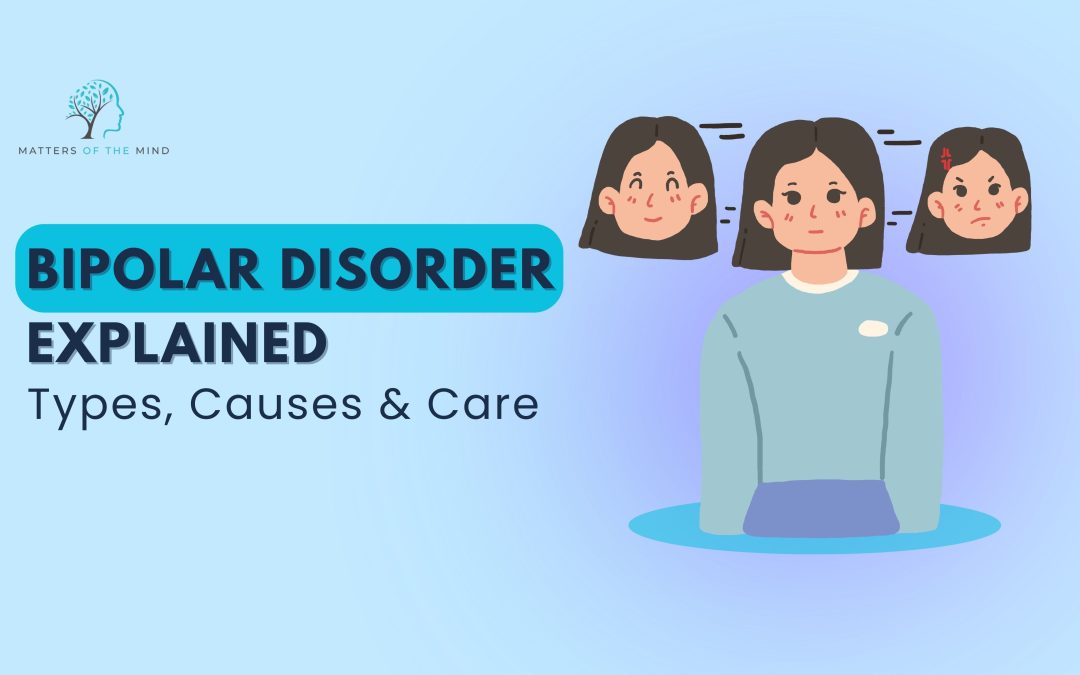What is Bipolar Disorder?
Bipolar disorder is characterised by shifts between two emotional states, mania (or hypomania, which is a milder form) and depression. These shifts are not the same as the everyday ups and downs people experience. Instead, they are more intense, long-lasting, and often disruptive to work, relationships, and personal well-being.
Types of Bipolar Disorder

1. Bipolar I Disorder
This is the most severe form, marked by at least one manic episode lasting a week or longer, or requiring specialisation. Depressive situations often follow, lasting two weeks or more.
2. Bipolar II Disorder
Individuals experience a pattern of depressive disorders and hypomanic disorders (a milder form of mania). While it is not as extreme as bipolar I, it can still disrupt daily life significantly.
3. Cyclothymic Disorder
This involves milder yet long-lasting fluctuations of mood. People may experience periods of hypomanic symptoms and depressive symptoms for two years or longer, though not as severe as bipolar I and bipolar II.
4. Unspecified Bipolar Disorders
Sometimes, symptoms don’t fit neatly into the categories above but still cause challenges in functioning. These forms also require attention and appropriate therapy treatment for bipolar disorder.
What Causes Bipolar Disorder?

- Genetics: Having a close family member with the condition can increase risk.
- Brain chemistry and structure: Imbalances in neurotransmitters and changes in brain activity are linked to mood regulation difficulties.
- Life events and traumas: While trauma or a highly stressful experience may not directly “cause” bipolar disorder, they can act as triggers for symptoms in someone already vulnerable. This is why many people who experience trauma might notice mood episodes emerging afterward.
- Environmental stressors: Loss, abuse, or a major life transition can activate underlying tendencies.
Signs and Symptoms of Bipolar Disorder
- Periods of extremely high energy, reduced sleep, or feeling unusually powerful.
- Racing thoughts, rapid speech, or impulsive spending/decision-making.
- Intense sadness, hopelessness, or feeling “stuck.”
- Changes in appetite, sleep, or ability to concentrate.
- Difficulty maintaining work, school, or relationships due to shifting moods.
Therapy and Treatment for Bipolar Disorder
1. Medication
2. Therapy
Bipolar disorder therapy provides individuals with tools to understand and manage their condition more effectively. Some widely used approaches include:
- Cognitive Behavioral Therapy (CBT): Helps identify unhelpful thought patterns and replace them with healthier, more balanced ways of thinking.
- Interpersonal and Social Rhythm Therapy (IPSRT): Focuses on building consistency in daily routines such as sleep, meals, and activity levels, which strongly influence mood stability.
- Family-Focused Therapy: Involves family members in the therapeutic process, improving communication and support while teaching loved ones to recognize early signs of mood shifts.
3. Lifestyle and self-care
- Simple lifestyle changes often play a powerful role in treating bipolar disorder.
- Maintaining a regular sleep schedule.
- Eating balanced meals at consistent times.
- Engaging in physical activity that supports emotional regulation.
- Reducing stress through mindfulness, relaxation, or grounding techniques.
Caring for Yourself or a Loved One
- Early recognition of mood shifts: Keeping a mood journal can help identify patterns.
- Building a strong support system: Friends, family, and peer groups provide encouragement and accountability.
- Regular therapy sessions: Consistency is key in reinforcing coping skills.
- Self-compassion: Understanding that recovery is not linear allows for patience and resilience.



